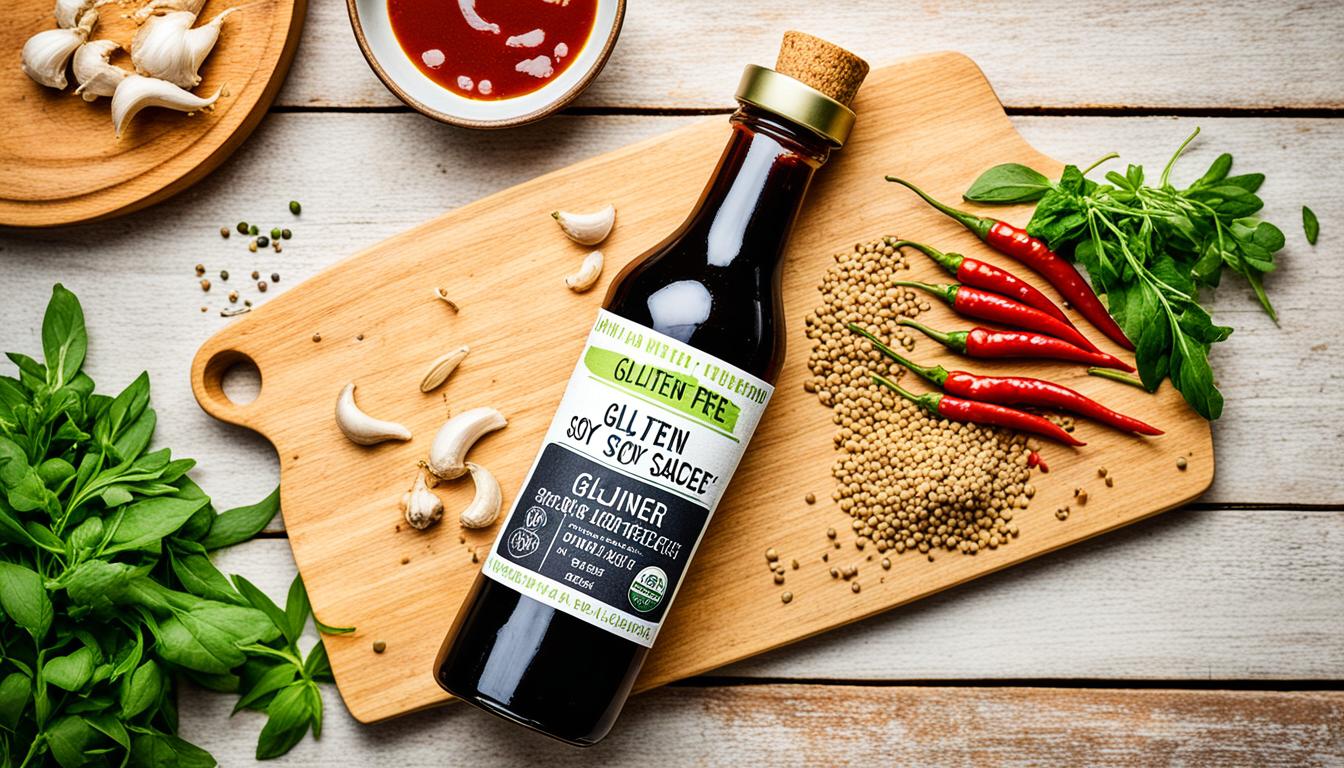Tired of the restrictions of a gluten-free diet? Longing for soy sauce but found no gluten-free options? You’re not alone. A whole new world of gluten-free soy sauce options is opening up1.
- Discover the wide range of delectable and allergen-free soy sauce alternatives that cater to your dietary needs.
- Explore the health benefits of choosing gluten-free soy sauce and how it can enhance your overall well-being.
- Learn about the unique production methods and nutritional profiles of traditional tamari and innovative coconut aminos.
- Dive into the world of international gluten-free soy sauce varieties and expand your culinary horizons.
- Unlock the secrets to successfully substituting gluten-free soy sauce in your favorite recipes and dishes.
This guide explores gluten-free soy sauce, offering tasty, healthy, and allergen-free options. It will change how you approach cooking and dining. Get ready for a flavorful journey where dietary limits won’t curb your palate’s adventure.
Understanding the Need for Gluten-Free Soy Sauce
Many dishes use traditional soy sauce. However, it can be hard for those on a gluten-free diet to enjoy it. This sauce gets its gluten when mixing soybeans with wheat, salt, and water. This makes it a no-go for people with celiac disease or gluten sensitivities2.
The interest in gluten-free diets is growing. So is the need for soy sauce that’s safe to eat for these individuals. Even a tiny bit of gluten can cause serious problems for those intolerant to it2. This is where gluten free soy sauce has become so important3.
Why Traditional Soy Sauce Contains Gluten
Wheat used in making traditional soy sauce is the reason behind its gluten. This ingredient is a big source of gluten, leading to issues for those avoiding it2. Even if some can handle a bit of gluten, it’s risky for those on a strict no-gluten diet4.
The Rise of Gluten-Free Diets and Lifestyle
The need for gluten-free items is higher than ever. This is because more people understand the health perks of going gluten-free3. This change in demand has pushed makers to offer safe choices, like gluten free soy sauce3.
With the rise of gluten-free diets, there’s a call for stricter rules on what’s labeled as such. Those with gluten sensitivities or celiac disease look for these labels to eat safely4. It’s important that the claims are backed by thorough testing and rules to keep them safe.
Knowing why gluten free soy sauce is a must helps us meet the needs of the health-conscious market. This conscious shift calls for safe, allergen-free options, and gluten free soy sauce is part of that change32.
“Any product labeled as gluten-free in the US must contain less than 20 ppm of gluten.”2
Health Benefits of Choosing Gluten-Free Soy Sauce
If you have celiac disease or are sensitive to gluten, using gluten free soy sauce is important. The FDA says food must have under 20 ppm of gluten to be labeled as such5. Gluten free soy sauce avoids the issues that can come with gluten.
Gluten free soy sauce options can be lower in salt than regular soy sauce5. For those watching their sodium, this is good news. Most tamari type soy sauces have no wheat today, using only soy5. Some, like coconut aminos, are made by aging salt and coconut blossom sap, naturally free of gluten5.
Traditionally, soy sauce contains wheat, which makes it unsuitable for those avoiding gluten5. But, some are made with rice instead. Pick a gluten free soy sauce to get the soy flavor without the gluten problems, supporting your health5.
“Switching to a gluten free soy sauce can be a game-changer for individuals with celiac disease or gluten sensitivities.”
The trend of gluten-free diets has grown as people learn about their health benefits. About 30% of adults in the U.S. are reducing gluten, not just those with celiac disease6. In the U.S., around 1 in 133 have celiac disease, but more may have non-celiac gluten sensitivity6.
Using gluten free soy sauce in your cooking is a healthy choice whether you need to avoid gluten or not. It offers delicious flavors and several health benefits. This sauce can make your meals tastier and better for you.
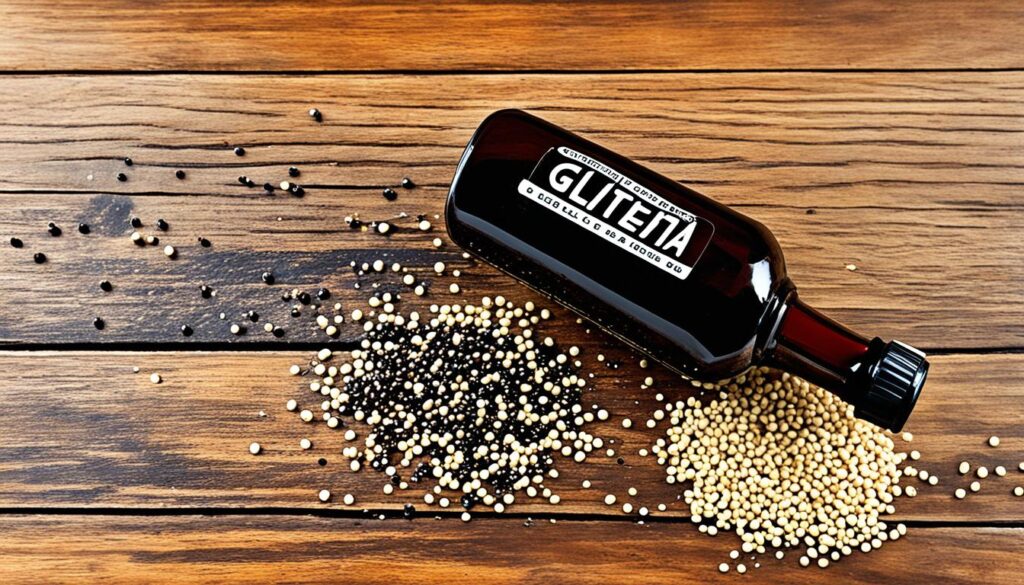
Tamari: The Traditional Gluten-Free Soy Sauce
Are you on a gluten-free diet and find soy sauce confusing? There’s a traditional Japanese type called tamari. It’s made without wheat, making it naturally gluten-free7.
What is Tamari?
Tamari has a rich, deep taste that’s not as salty as regular soy sauce. The traditional brewing process brings out the soybeans’ natural umami. This makes tamari great for all kinds of dishes, like marinades and stir-fries7.
Nutritional Profile of Tamari
Kikkoman produces a top-quality tamari, which is both gluten-free and nutritious7. A 250ml bottle costs £3.35, or £2.23 per 100ml, making it a good buy8. It has 0g of fat and just 9 calories in each tablespoon8. Plus, each 100ml offers 10g of protein and 16.4g of salt8.
Customers love its authentic taste and how easy it is to use. The bottle’s built-in pourer helps measure it precisely. Kikkoman Tamari is a hit with many diets, including gluten-free, halal, and vegan8.
Besides being gluten-free, Kikkoman Tamari has no GMOs or additives. It’s made of soybeans, salt, spirit vinegar, and water8. Its nutritional values include 240 kJ of energy, 2.0g of carbs, and no sugars per 100ml8.
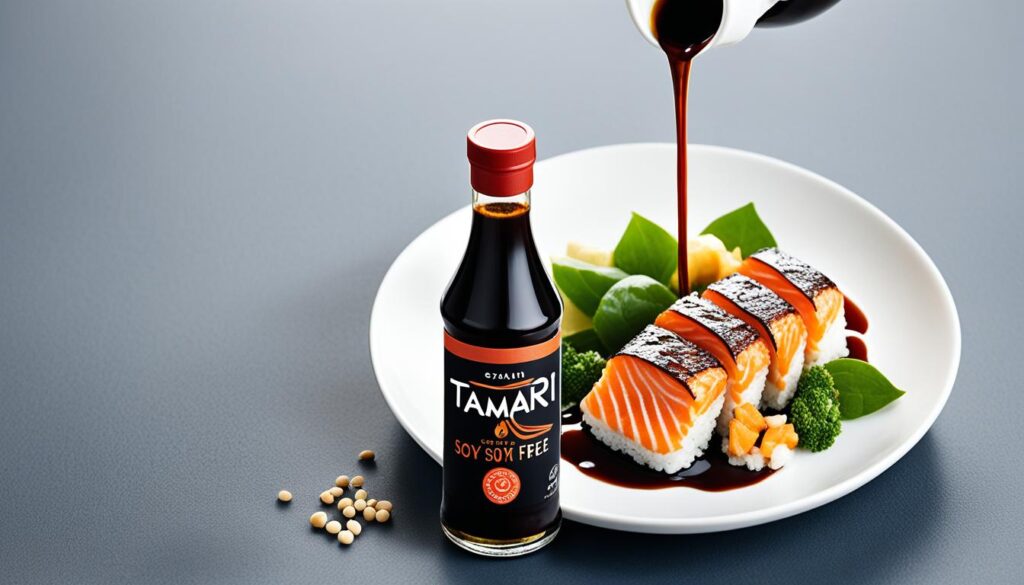
If you’re looking for a gluten free soy sauce, try tamari. It has a great taste, is very nutritious, and can be used in many recipes. Tamari is a kitchen essential for those living gluten-free7.
Coconut Aminos: A Flavorful and Allergen-Free Alternative
Looking for a tasty, allergen-free swap for soy sauce? Coconut aminos are the answer. They’re made from the sap of coconut palms. This makes them taste a bit sweeter and are less salty than soy sauce9. Also, they have way less sodium and don’t include soy at all10.
The Benefits of Coconut Aminos
One big plus of coconut aminos is they’re healthier when it comes to sodium. A teaspoon of soy sauce has about 280 mg of sodium. But a teaspoon of coconut aminos has only 90 mg10. For people who need to cut down on salt, coconut aminos are a smart pick. This is in contrast to liquid aminos, which have even more sodium than soy sauce10.
Besides being lower in sodium, coconut aminos have a taste all their own. They add a sweet, complex flavor to your food. You can use them in almost anything, like marinades, dressings, or stir-fries. And let’s not forget, they are soy-free, which is great news for folks with soy issues9.
Yes, coconut aminos might be a bit pricier than soy sauce. But, the health benefits and being free from allergens make them a good buy10. Plus, they are very low in sugar. This is unlike many soy sauce alternatives, which can have a lot of added sugars10.
If you can’t have soy or just want a healthier choice, coconut aminos are a top pick. They’re good for your health, taste great, and are soy-free. So, give them a try in your cooking and see the difference9.
Bragg Liquid Aminos: A Smoky, Gluten-Free Option
Are you seeking a special soy sauce that’s gluten-free and tastes smoky? Bragg Liquid Aminos is the answer. It’s a non-GMO substitute made from soybeans and water. This means it doesn’t have wheat or gluten11. It has a bit more sodium, but it brings a delicious layer of flavor to your food.
This sauce is very versatile. You can use it in many meals, like marinades and dressings, or in stir-fries and sauces12. For a tasty veggie stir-fry, mix Bragg Liquid Aminos with maple syrup, olive oil, and apple cider vinegar. It will make your veggies pop with taste.
Being gluten-free is one plus of Bragg Liquid Aminos. It’s also Certified Non-GMO12. This is good news for those who want to avoid GMOs. It has a bit more sodium, but its unique smoky taste is a great bonus for your dishes.
If you’re on a gluten-free diet or looking for new soy sauce, try Bragg Liquid Aminos. It will bring a flavorful kick to your cooking111312.
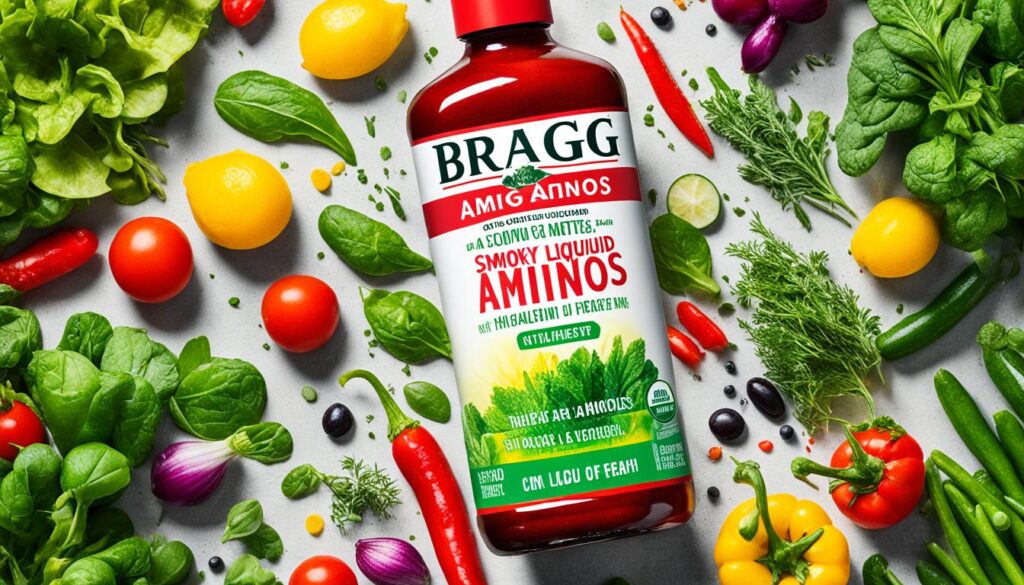
Gluten-Free Soy Sauce Brands to Look For
There’s a big need for gluten free soy sauce options. Many brands have started making such products. You can find them in stores and online14.
Popular Gluten-Free Soy Sauce Brands
San-J, Kikkoman, Coconut Secret, and Bragg are high on the list. For over twenty-two years, San-J has led in gluten-free soy sauces14. Minamigura’s Tamari Shoyu is aged for 3 years in barrels. Momofuku offers a new Tamari sauce14. Handa’s Tamari Shoyu tastes a bit bitter and saltier than others14.
San-J and Kikkoman stand out for their great taste and availability15. They’re certified gluten-free. San-J even offers small travel packs15. Kikkoman’s Gluten-Free version is available in bulk sizes for ordering15.
Regular soy sauce uses wheat in its making. Tamari, without wheat, is said to be slightly less strong in taste15. But, there’s a wide range of soy sauce types from various Asian places15.
Gluten comes from wheat, rye, barley, and similar grains16. Soy sauce has about 280 mg of sodium in a teaspoon16. San-J and Kikkoman are known for their gluten-free sauces. Coconut aminos is an alternative, made from coconut sap and salt. You can find brands like Coconut Secret, Big Tree Farms, and Primal Kitchen offering these16.
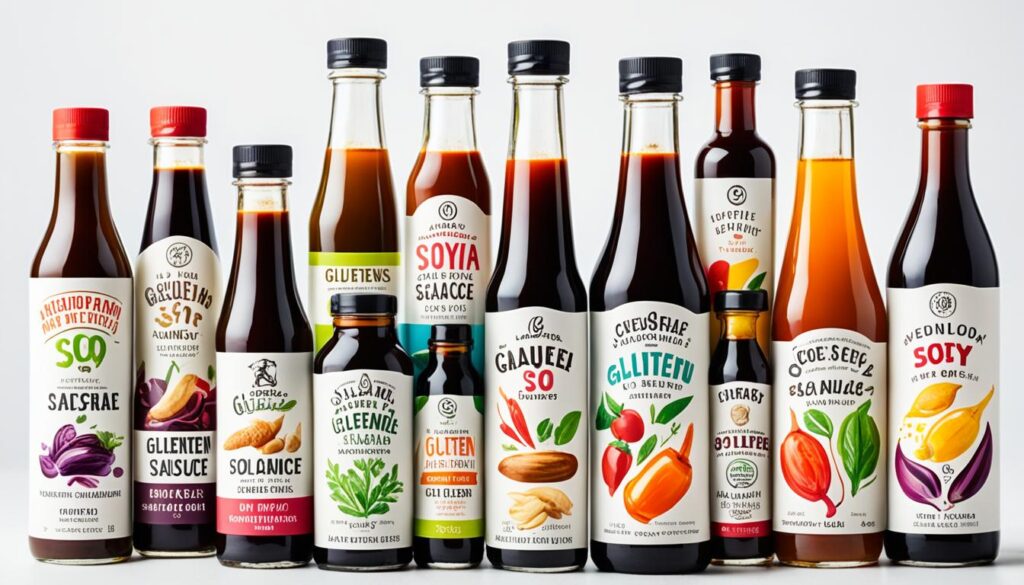
Using Gluten-Free Soy Sauce in Cooking
Adding gluten free soy sauce to your recipes opens a world of flavor. You can use it in many dishes, like stir-fries and dressings17.
Substituting in Recipes
Gluten free soy sauce works great in place of the regular one. It’s perfect for stir-fries or marinating meats, giving the same delicious taste without gluten17.
Gluten-Free Soy Sauce in Marinades and Dressings
It’s more than just a swap in recipes. Gluten free soy sauce adds a unique savory kick to marinades or dressings. Try different brands to see which one you like the most17.
| Gluten Free Soy Sauce Brand | Flavor Profile | Recommended Uses |
|---|---|---|
| Kikkoman Gluten Free Soy Sauce | Traditional savory and umami-rich flavor | Marinades, stir-fries, dressings |
| Trader Joe’s Gluten-Free Soy Sauce | Slightly sweeter and less salty than traditional soy sauce | Dipping sauces, marinades, glazes |
| San-J Tamari Gluten-Free Soy Sauce | Richer, more robust flavor profile | Stir-fries, braises, dressings |
Choosing a gluten free soy sauce brand is about exploring. Find the one that fits your flavor and cooking style best. Soon, you’ll be creating amazing gluten-free dishes18.
“Embracing gluten free soy sauce opens up a world of culinary possibilities for those with dietary restrictions or sensitivities.”
Ready to dive into the variety of gluten free soy sauce? It’s great for any cook, beginner or experienced. Enjoy new flavors in your dishes while keeping to your dietary requirements18.
Sodium Content in Gluten-Free Soy Sauce Alternatives
Gluten-free soy sauce alternatives are becoming more popular. It’s key to look at their sodium levels. They are a safer choice for those avoiding gluten. But, some are still high in salt19.
A teaspoon of regular soy sauce usually has 300 to 400 mg of sodium19. Yet, reduced-sodium kinds can contain about half of that19. When picking a gluten-free soy sauce, always check the label. Choose one with low sodium if you watch your salt.
Coconut aminos have only 90 mg of sodium per teaspoon, much less than soy sauce’s 290 mg20. Meanwhile, Bragg Liquid Aminos have 320 mg per tsp1920. Reduced-sodium tamari sauces, which are also gluten-free, might have similar sodium levels to reduced-sodium soy sauce19.
The rise in demand for low-sodium, gluten-free, and soy-free choices has spurred many soy sauce alternatives1921. When cooking with these, remember to tweak your seasonings. This is to match their different flavors and sodium content for the best taste21.
If you’re watching your sodium, using low-sodium broth as a base in recipes can help cut down on overall salt. This can be a good approach when swapping in gluten-free soy sauce substitutes21.
| Soy Sauce Substitute | Sodium Content (per serving) |
|---|---|
| Regular Soy Sauce | 300-400 mg per teaspoon19 |
| Reduced-Sodium Soy Sauce | 150-200 mg per teaspoon19 |
| Tamari (Reduced-Sodium) | Comparable to Reduced-Sodium Soy Sauce19 |
| Coconut Aminos | 90 mg per teaspoon20 |
| Bragg Liquid Aminos | 320 mg per teaspoon1920 |
Soy sauce substitutes are becoming more popular due to consumer demand for low-sodium, gluten-free, and soy-free options19.
Exploring International Gluten-Free Soy Sauce Varieties
Many gluten-free soy sauce options can be found in the West, making cooking easier for those with allergies. Yet, looking beyond local stores opens up a world of choices. Asian cultures have used soy sauce for millennia, making a vast array of gluten-free kinds22.
Japanese and Korean Gluten-Free Soy Sauces
Japan and Korea offer unique, gluten-free soy sauces unique to their cultures. In Japan, koikuchi shoyu and usukuchi shoyu are key. Koikuchi shoyu is darker and usukuchi is lighter, used mainly in the Kansai area for certain dishes22.
Tamari is another option, made as a byproduct of miso. It’s often gluten-free, perfect for those with wheat allergies. Major brands prepare tamari without wheat for a safe choice22.
In Korea, their soy sauce, ganjang, brings a unique taste. It’s less salty than many others and its aging process adds a complex flavor. It’s a great option for meals requiring a gluten-free sauce23.
From the bold flavors of koikuchi shoyu to the subtlety of usukuchi, the variety in gluten-free soy sauces is immense. Trying these sauces from Japan and Korea can revolutionize your cooking. These sauces not only taste great but are also safe for those allergic to gluten2223.
Gluten Free Soy Sauce: A Game-Changer for Allergen-Free Diets
Finding tasty gluten-free soy sauce alternatives has been a big deal for those on allergen-free diets. It means people with celiac disease, gluten sensitivities, or other needs can still enjoy soy sauce’s delicious umami24. This change has helped many stick to their diet while enjoying a variety of foods.
Kikkoman’s Tamari gluten-free soy sauce stands out24. Kikkoman, known for their top-selling soy sauce, brings us this special variety24. It’s made without wheat, so it’s great for those avoiding gluten24. Its ingredients are water, soybeans, salt, and spirit vinegar, offering the real soy sauce taste but without gluten24.
Kikkoman’s Tamari is unique for its top-notch quality and how it avoids allergens25. The sauce is slowly aged using a special brewing method for the best taste24. It also meets vegan standards and is Halal certified, making it suitable for various diets24.
Today, more people are choosing gluten-free diets and learning about food allergies. So, the need for safe yet tasty soy sauce is higher than ever25. Kikkoman’s Tamari has stepped in, offering a key solution24.
This sauce’s entrance into the market has changed the game for those needing to avoid allergens. Now, they can enjoy their favorite foods without worry24.
In short, the arrival of products like Kikkoman’s Tamari has been a big win for those with food allergies or sensitivities24. These sauces are safe, taste great, and satisfy the need for flavorful allergen-free options24. With more and more people looking for these choices, we can expect to see even more in the future24.
Conclusion: Embracing Gluten-Free Soy Sauce for Flavor and Health
In conclusion, the rise of gluten-free soy sauce alternatives meets the needs of many. It offers great taste without gluten for those with specific dietary needs. Options such as tamari, coconut aminos, and Bragg Liquid Aminos give you soy sauce flavors, but without gluten. These choices are also healthier, with less sodium26.
Choosing gluten-free soy sauce can change how you enjoy food and help your health26. For people sensitive to gluten, cutting it out can lower issues like swelling27. It can also make a big difference in daily life, easing things like bloating and tiredness27. Adding this soy sauce to your dishes helps you stay healthy and enjoy your meals more27.
More and more, allergen-free items, like gluten-free soy sauce, are easy to find. Brands like Amazon, Blue Diamond, and Ayam offer top-quality choices28. People with celiac disease or serious gluten issues can use these sauces safely28.
By including gluten-free soy sauce in your cooking, you add flavor and health benefits to your meals. It’s a small but powerful change you can make26.
FAQ
What is the difference between regular soy sauce and gluten-free soy sauce?
Traditional soy sauce contains wheat, which adds gluten. This makes it a no-go for those avoiding gluten. Gluten-free options like tamari and coconut aminos are free from wheat. People with celiac disease or gluten sensitivity can safely use these.
What are the health benefits of using gluten-free soy sauce?
Switching to gluten-free soy sauce has health perks. It’s safer for those with gluten issues. Many alternatives are also lower in sodium. This is good news for people trying to limit their salt.
What is tamari, and how is it different from regular soy sauce?
Tamari is soy sauce brewed without wheat. It’s known for its deep, less salty taste. It’s a great gluten-free option for various dishes.
What is coconut aminos, and how does it compare to soy sauce?
Coconut aminos come from coconut palm sap. They taste like soy sauce but are sweeter and less salty. They’re soy-free, making them perfect for allergy-prone individuals. Plus, they have less sodium than typical soy sauce.
What are some popular brands of gluten-free soy sauce?
Look out for brands like San-J, Kikkoman, Coconut Secret, and Bragg. They carry gluten-free soy sauce, tamari, and coconut aminos. Find them at many stores and online.
How can I use gluten-free soy sauce in my cooking?
Use them just like regular soy sauce in recipes. Think stir-fries, marinades, and dressings. They offer the same taste. They’re also great in marinades and dressings for that umami kick.
Are all gluten-free soy sauce alternatives low in sodium?
Not all. Some can still be high in salt. Regular soy sauce has 300-400 mg of sodium per teaspoon. Check labels for lower-sodium options if you need to cut back on salt.
Are there any international gluten-free soy sauce varieties to explore?
Yes, beyond what’s common in the West, other options await. For instance, Japan and Korea have tamari and ganjang. These add unique flavors and stay true to gluten-free diets.
Source Links
- Gluten Free Tamari Soy Sauce from Igeta Shoyu – 150ml
- Is Gluten in Soy: The Truth Behind the Label | Curry Girls Kitchen
- Does soy sauce contain gluten?
- Soy Sauce: More insightful news from FDA based on Gluten Free Watchdog FOIA requests – Gluten Free Watchdog
- Is Soy Sauce Gluten-Free?
- Gluten-free diet: Health benefits, risks, and foods
- Gluten Free Soy Sauce vs Tamari Tasting
- Kikkoman Tamari Gluten Free Soy Sauce | Ocado
- Tamari vs Soy Sauce vs Coconut Aminos
- Coconut Aminos: Is It the Perfect Soy Sauce Substitute?
- Soy-Sauce Substitutes: Options for Gluten-Free or Soy-Free Eaters
- Veggie Stir Fry with Bragg Liquid Aminos
- 6 Benefits of Liquid Aminos (Plus Potential Downsides)
- The Best Tamari (Gluten Free Soy Sauce) Brands
- The Best Gluten Free Soy Sauce — Glutenary
- Does Gluten Free Soy Sauce Exist? – Gluten Free Society
- Gluten Free Soy Sauce Recipe | culinarycrush
- Your guide to gluten free sauces and condiments
- Soy-Sauce Substitutes: Options for Gluten-Free or Soy-Free Eaters
- 12 Tasty Alternatives to Soy Sauce
- Gluten Free Soy Sauce Substitute: 10 Top Picks Alternatives
- A Guide to Soy Sauce Varieties
- Uncover the Different Types of Soy Sauce: A Complete Guide
- Check out Kikkoman Gluten Free Soy Sauce 150ml now from EMERSONS SUPERMARKET ARMAGH on APPY SHOP!
- Check out Kikkoman Tamari Gluten Free Soy Sauce 250ml now from LONDIS FERME PARK ROAD on APPY SHOP!
- The Role of Healthy Sauces in Meeting Dietary Restrictions
- Embracing a Healthier Lifestyle: The Benefits of Gluten-Free Eating and a Delicious Recipe to Get You Started
- Navigating a Gluten-Free Diet: Is Sesame Oil Gluten Free?

